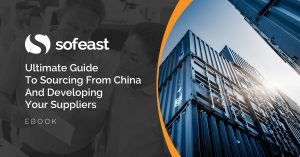The situation in Hong Kong, the US/China trade war, mistrust of China and attempts at decoupling, and other news stories are rightfully a cause of concern for importers with Chinese suppliers. But the manufacturing challenges you should be concerned the most about are those that may prevent you from receiving the products you expect from your suppliers.
These challenges can be categorized into 7 different areas and often occur due to a lack of transparency which is either intentional or a cultural phenomenon. So let’s discuss what the challenges are and how to mitigate them.
7 areas prone to issues caused by a lack of transparency
This episode of the podcast stems from a blog post I wrote on the ‘China Law Blog’ titled: Verifying and Monitoring Your Chinese Suppliers. In it, I discussed 7 areas when dealing with a Chinese supplier which are prone to problems caused by the opacity of suppliers.
Listen to the episode right here 👇👇👇
Here’s a quick run-down of the manufacturing challenges and content discussed in this episode:
- Why these problems can bring down your business – for example, bad quality, loss of IP, and unreliable suppliers can all damage or kill your new production. See also podcast episode on social compliance audits (referred to here).
- Supplier screening & qualification – about how suppliers may keep your supply chain information a secret from you in order to have leverage.
- New product development (manufacturing side) – suppliers may not explain why price rises occur or why they’re rushing to mass-production instead of focusing on important pre-production steps like a pilot run.
- New product development (design side) – the importance of keeping control over product designs and other IP, and why certain suppliers like ODMs will not want to give this to you due to secret self-serving motives. See also the podcast episode on choosing the correct supplier (relevant to this section).
- Confidentiality of information – why buyers can’t always rely on suppliers keeping their information safe, even if they agree to do so.
- Purchasing materials & components – how counterfeit or substandard components and their use in productions is surprisingly common and can catch you out if you’re not vigilant.
- Manufacturing (Sub-contracting) – the dangers of sub-contracting even after a manufacturer has agreed to produce your products in-house.
- Your supplier selling your products without permission – how suppliers, especially those with your tooling, may start producing your products to sell themselves!
Of course, all of the above issues are made a lot worse because they often occur without your knowledge, so background checks, auditing, quality inspections, and all kinds of due diligence become all the more important, especially in today’s post-COVID climate where travel to China is limited.
Please note, these issues are not limited to China – the examples and advice given here apply to suppliers in most countries!
Extra reading
All of the following blog posts are relevant to the topics we discussed in this episode:
- The Danger of Developing your Custom Product with an ODM Factory
- OEM, ODM, Contract Manufacturers: Choose your China Supplier Wisely
- Blog posts on vetting Chinese suppliers
- Don’t Skip the Pilot Run for Your New Product Made in China!
- 6 Effects of Signing a Strong Manufacturing Contract with your Supplier
- 8 Ways to Prevent Chinese Suppliers from Subcontracting
- Manufacturing in China can be risky! 10 Examples of China IP Theft
*****
How do you manage suppliers in China (or elsewhere) to protect against these manufacturing challenges caused by a lack of transparency? Let me know your tricks and tips.
Subscribe to the podcast
There are more episodes to come, so remember to subscribe! You can do so in your favorite podcast apps here:
- Apple Podcasts
- Spotify
- Stitcher
- Google Podcasts
- TuneIn
- The podcast’s website at China Manufacturing Decoded
Ultimate Guide To Sourcing From China And Developing Your Suppliers [eBook]
This FREE eBook starts from the beginning, discussing whether you need to hire a sourcing agent, and follows the sourcing process right through to developing a trusted supplier’s quality and productivity.
There are 15 chapters over 80+ pages to explore, providing exhaustive guidance on the entire sourcing and supplier development process from start to finish, including:
- Identifying suppliers,
- Negotiations,
- Quality inspections,
- Developing Chinese suppliers,
- Improving factory quality and productivity,
- and much more…


